Hello gents, if you look in another part of this forum, you will notice that I have constructed a bullet catching box. This box was designed to catch cast bullets with as little damage as possible and see what is really happening at high velocity. The reason I wanted to do this is that the participant's in the XCB project (acronym for eXtreme Cast Bullet project) who I have built slow twist rifles for, seem to have hit a wall at 3000FPS, past which accuracy begins to degrade. (By accuracy I mean groups open to more than 2MOA). Well, I wanted to see what was going on, so I built the box, and with the help and witness of Glenn Larson of White Label Lubes, and using the XCB rifle I built for him, we proceeded to fire bullets into a sawdust filled tunnel 85 yards away. What we found was intriguing, and I thought you might like to see it. The bullets were sized down to extremely small diameters. The bullets were cast by me of Lyman #2 alloy, lubed with 2500+, and tested for hardness at 22BHN. These particular bullets were loaded in the 30-06 XCB case over 51 grains of H414 powder, and they achieved a chronographed velocity of 2900FPS average. The bullets were cast at .311. They were sized to .310. They were fired through a .307 diameter barrel. But this is how much smaller each point was on the recovered bullet than what it was when it entered the barrel: Bottom of the GC shank: -.002 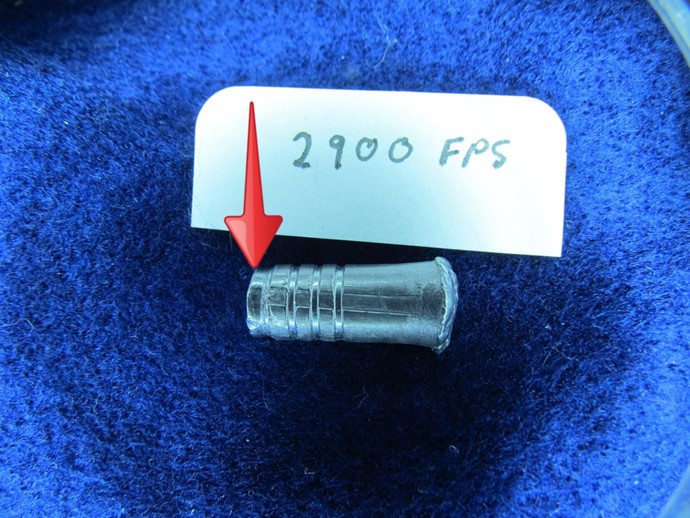 front of the GC shank: -.015 (yes, that's fifteen thousandths of an inch)
front of the GC shank: -.015 (yes, that's fifteen thousandths of an inch) 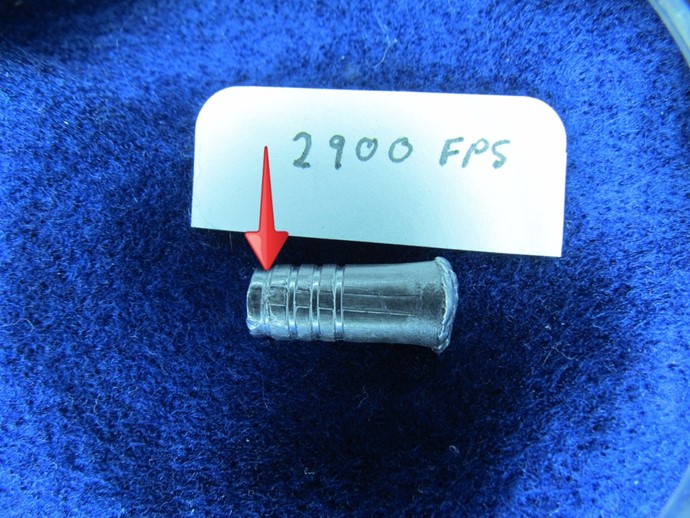 First driving band: -.004
First driving band: -.004 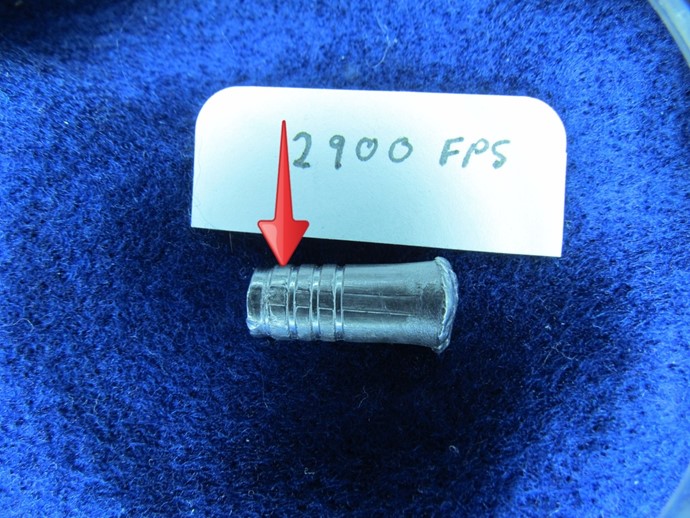 second driving band: -.002 T
second driving band: -.002 T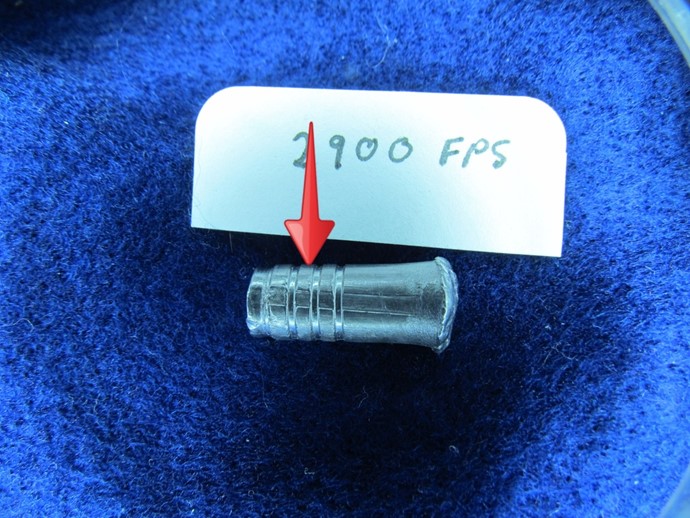 hird driving band: -.001
hird driving band: -.001 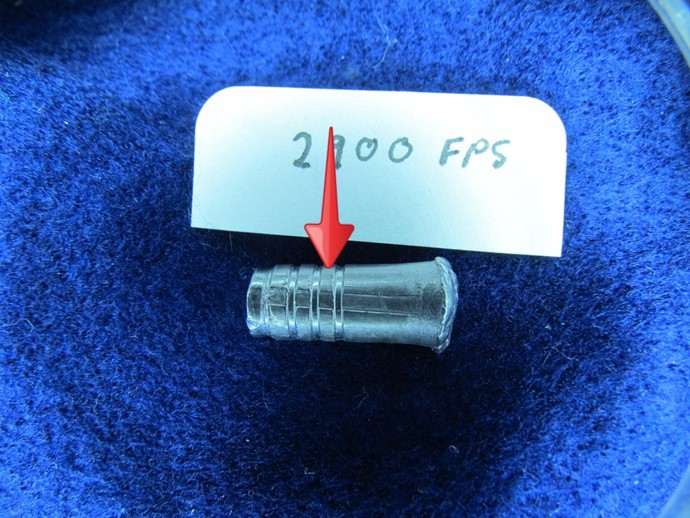 Fourth driving band: -0.00
Fourth driving band: -0.00 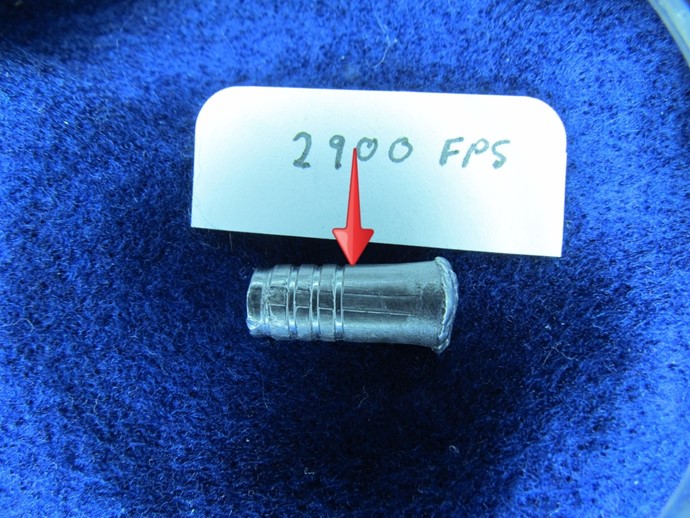 I believe this sizing of the bullet was caused by hydraulic action from the lube piling up in front of the GC and producing a high pressure area there. Thought some might find that interesting. BTW, sorry about the deformed bullet. It passed through 5 feet of sawdust and had a lot fo slowing down to do. Bullets shot at lower velocities exhibited less and less of this sizing , but even at 2500FPS, the area of the shank under the rim of the GC was still sized down .010, while the driving bands were only reduced by .0005-.001. In fact, I could almost tell how fast the bullets were going by how badly they were sized down.
I believe this sizing of the bullet was caused by hydraulic action from the lube piling up in front of the GC and producing a high pressure area there. Thought some might find that interesting. BTW, sorry about the deformed bullet. It passed through 5 feet of sawdust and had a lot fo slowing down to do. Bullets shot at lower velocities exhibited less and less of this sizing , but even at 2500FPS, the area of the shank under the rim of the GC was still sized down .010, while the driving bands were only reduced by .0005-.001. In fact, I could almost tell how fast the bullets were going by how badly they were sized down.
HV bullet damage. Interesting results.
- 2.1K Views
- Last Post 22 January 2016
Attached Files
Too many lube grooves? Have you tried filling just one lube groove and test? One thing that a have learned in this forum and shooting is less lube equals better accuracy.
I am sure the hydraulic pressure causes gas checks to pop off. A short gas check shank is best, short enough for gas check to butt against band and allowing no lube to enter.
...
Attached Files
Perhaps going down from a .310 leade and bullet, to a .3085-.3090 will help (less sqeeze).
...
Attached Files
It's possible that butting the GC against the bottom most drive band would create a bit of a labyrinth seal, but this much deformation is really hard to get around. The lube will move till it cannot move any more, and that point is where the GC stops it, and at that point, the lube builds enough pressure to pinch the bullet .015 inches. Seems to me that's less than the opening to the GC.
Understand also, we are talking about blazing fast cast bullets here. Very few people would see this even if they recovered the bullets. The “low velocity” shots I took were running 2500FPS.
The lube grooves were created as small as I thought I could get away with. They are only .008 deep and only .030 wide at the widest point. Lee TL grooves look large and deep in comparison. In fact, I designed the XCB bullet to take advantage of modern lube and I do not know another designer other than Lee who has taken that approach.
Glenn has told me that he intends to thoroughly clean his barrel and fire a bullet or two without lube at 2900FPS and see what happens. I'm looking into tumbling some XCB bullets in moly like is used to treat jacketed bullets.
Attached Files
I would install gas check and size first before tumbling hard cast bullet (gently).
I tried the old DOW brand spray on moly with bad results. Maybe the newer Lyman brand works better.
...
Attached Files
Tim,
You are working in an area of unknowns to us old timers. But consider that the bullet is a wad of bubblegum going down the barrel. What other possibilities? You are in an unexplored world. We are guessing now.
Ric
Attached Files
Ric, guessing is what you do in preparation for, or in the absence of, a good scientific test, with the former being much preferred to the latter.
I work two jobs. One is gunsmith and the other, I am lead machinist in an aerospace company. I went and talked to some engineers who are friends of mine, one of whom is well versed in fluid dynamics. I explained what had happened, and he agreed that under these conditions, hydraulic swaging is the most obvious conclusion, and possibly the only one.
OU812: That's exactly what I intend to do. The bullets are cast of Lyman #2 water quenched, and I'm sending them to a friend in Florida who has the dry moly tumbling setup.
One thing that I was actually not trying to test but did anyway, was the feasibility of using Lyman #2 casting alloy for hunting with the XCB bullet. Seems once you cross 2600, things start to work that didn't before. These bullets were not HPed, nor air cooled, and yet the expansion is superb. The accuracy was also very very good, and we had to intentionally shoot different spots on the target to avoid hitting the bullets inside the box
Attached Files
Nice to see some experimental result instead of just opinions and theories. But of course we can then argue about the theories needed to explain the experimental results.
I assume that the pictures look like the front driving band has expanded is just the angle the picture was taken. The reduction of the gas check shank gives a tiny bit of a boat tail which would give a tiny bit of ballistic advantage at long distances. Maybe you should figure out how to reduce the tail more instead of less. heh heh as Ken says.
Very interesting stuff. Keep up the good work.
John
Attached Files
More of a “dovetail” wouldn't you say John? The GC shank was not reduced at all where it contacts the GC. Only the area behind the first driving band was reduced. In fact, the GC shank resembles the skirt of an air rifle pellet.
Attached Files
The bullets I recovered at 300 yards and showed pictures of in the RPM thread showed the same as what goodsteels recovered bullets showed. The bullets I recovered had a 2900 fps muzzle velocity and a probable impact velocity of 1850 - 1900 fps. Here's two of them; one with the GC still on and the other without the GC. Note on the one sans the GC the “pellet skirt” shape of the GC shank. I recovered 5 bullets and all were reduced in diameter to .303 - .305. The GCs were also reduced in diameter. Yes isn't actual experimental results nice to see. LMG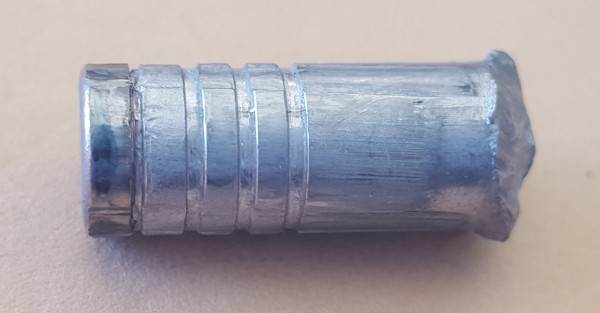
Concealment is not cover.........
Attached Files
 With out GC
With out GC
Concealment is not cover.........
Attached Files
thank you thank you thank you ...
you just might have inspired certain of us to stop just having fun plinking with old rifles and actually contribute something ...
to be clear :: this was lyman #2 alloy, right ??
you with the gadgets probably knew you would get a few requests for non-applicable tests ... but just in case you don't, here are a couple of mine ... heh heh ...
1) some #2 castings with no gas check .... both full lube and with no lube at all .
2) a few with that troubled child of lead bullets ... the 22 rimfire
and just to complete the loop .... are we sure the distortion occurs in the barrel and not in the chip filled casket ??
re: the moly coat ... i am pretty sure you don't need a perfect moly coat to be valid ... if it were me, i would run a couple moly powdered patches down the barrel before shooting and the speckled coating bullets would be just fine ... and maybe even too much .
thank you again ...
ken
Attached Files
<url=/view_user.php?id=8104>goodsteel wrote: More of a “dovetail” wouldn't you say John? The GC shank was not reduced at all where it contacts the GC. Only the area behind the first driving band was reduced. In fact, the GC shank resembles the skirt of an air rifle pellet. And now a word from the “wet blanket” people... The photo is an unfired 30 caliber bullet sized to .309. Pried off the gas check and I see a airgun pellet-looking gas check shank, too. (On the undistorted left side). The shank next to the base band measured .282. The gas check crimp groove measured .277. The rear end of the pellet skirt measured .282. These are with my calipers which measure differently than my micrometers. The rear band still measures .309.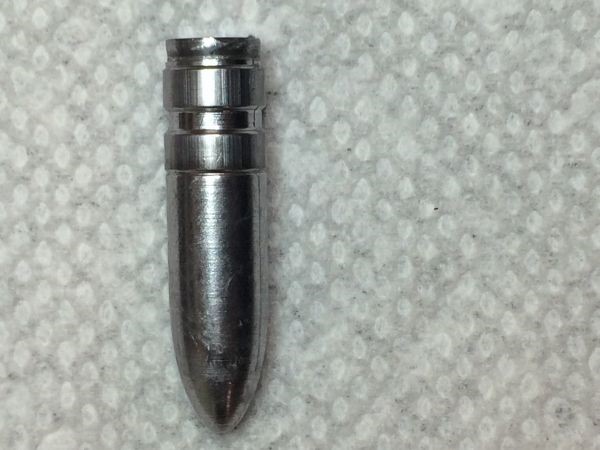
Attached Files
Paul, Was that a Hornady gas check that you pried off? At least now we know where the “dovetail” effect comes from, but what about the reduction in size of the bottom two driving bands. How does that occur? Brodie
B.E.Brickey
Attached Files
Hornady gas check.
Gootsteel is amazing. While most people are contemplating what medium to use, he builds a box, fills it with sawdust, shoots the bullets, takes pictures and posts results.
On a related note to the undersized rear bands:
I made a spring loaded die which was supposed to auto-eject the bullet after sizing and applying the gas check. The spring was supposed to keep the gas check tight on the base. The bullet would sometimes stick and would need a tap of a hammer on the eject rod. When that happened the bullet would shorten .020” or so. More lube on the bullet solved that problem and the bullets ejected with just the spring doing the work. The length remained the same as before sizing. After about 2000 bullets, I took some measurements and found the rear of the rear band was .2425, not the expected .244. It wasn't until after tapering the front band that the undersized rear band showed up. The micrometer had measured across the gas check to the front band. It spanned the undersized rear band. The excess lube had worked to eject the bullet, but had helped to undersize the rear band. The lube pushing to the rear of the bullet during firing may be doing the same thing.
Another die to the scrap heap!
Attached Files
if hydraulic pressure is needed for successful ...” lubrication ” of high speed cast bullets ..... we might find that tests with dry moly powder lube .... will show failure ...
but if they work at low speed ... why is that ??
to be continued ..... hmmmm ... dang i hate these waiting spells ...
i used moly in a grease... lyman is moly in a wax ...
do we realize there are more combinations than * powerball * ... ??
ken
Attached Files
Paul pollard, that's really great info there. I hadn't even thought of that, and it totally explains the little step I was seeing in the GC shank. Good catch!!!!
HOWEVER.......... My GC shank was sized significantly more than yours is. You demonstrate a difference of only .005, while I measured a difference of three times that amount. That can't be easily dismissed.
Also, like Old Coot mentions, it does not explain the reduction in size of the driving bands. Another fact not easily dismissed.
Your observation is spot on, but I am standing pat on my original observations.
Attached Files
goodsteel, How thick is the metal on the rim of YOUR gas checks? As for the smaller driving bands; I will accept hydraulic action from lube as a primary hypothesis. Perhaps you should also try moly and maybe 45/45/10 recluse just to see what that does to bullet on firing.
You may also want to look at some jacketed slugs (preferably as thin a jacket as possible) to see if there is any deformation of the shank toward the base. Perhaps it is the lack of deformation or great reduction in deformation that would explain why jacketed bullets shoot so much more accurately than cast from the same gun. Brodie
B.E.Brickey
Attached Files
That's a tough question to answer Mr. Brodie. This is an un-uniformed gas check that I have carefully bisected. You see the difficulty of measuring this? The rim is not simply an edge you can snap a pin micrometer on. It's a strange shape. 
Attached Files
goodsteel, I was trying to get a handle on how much the gas check would squeeze the shank of the bullet in when it was crimped on. I am firmly convinced that this is the cause of the “mushroom” shape of the bullet base. Not some other interaction, just the simple reduction in size due to the thickness of the gas check as it is being seated and crimped into place.
Like I stated the deformation and lengthening of the bullet shank by possible hydraulic action of the bullet lube is a very distinct possibility. Perhaps we will have to fire some cast bullets without lube to see if deformation of the shank occurs without the presence of lube.
And after you are done with that you can run diagnostics on all the lab equipment and wash up the glass ware. LOL Brodie
B.E.Brickey
Attached Files
Categories
- All Categories
- General Polls
- Contact Us w/ Forum Issues
- Welcome to The Cast Bullet Association Forum
- General
- Bullet Casting
-
Guns and Shooting
- AR Platform
- TC Contenders & Other Single Shot Handguns
- Shotguns
- Informal Matches & Other Shooting Events
- Gunsmithing Tips
- Gun Cleaning & Maintenance
- Optics
- Benchrest Cast Bullet Shooting
- Military Bench Rest Cast Bullet Shooting
- Silhouette Shooting
- Postal Match Cast Bullet Shooting
- Factory Guns
- Black Powder Cartridge
- Hand Guns
- Lever Guns
- Single Shot Rifles
- Bolt Action Rifles
- Military Surplus Rifles
- Plinkers Hollow
- Muzzleloaders
- Hunting
- Reloading
- Buy, Sell or Trade
- Other Information & Reference
Search
This Weeks High Earners
-
John Carlson 22
-
 linoww
17
linoww
17
-
 Bud Hyett
14
Bud Hyett
14
-
drone 9
-
MP1886 7
-
beltfed 6
-
Lucky1 6
-
 RicinYakima
5
RicinYakima
5
-
mashburn 4
-
 Aaron
3
Aaron
3






